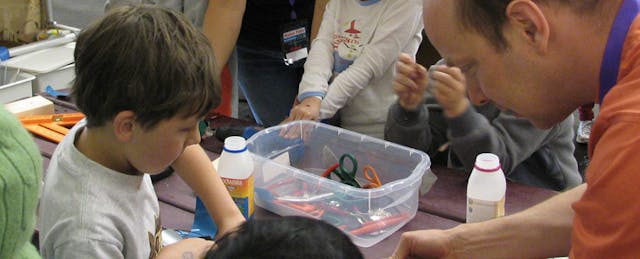Okay, I confess: I love this book.
Invent to Learn: Making, Tinkering, and Engineering in the Classroom by Sylvia Libow Martinez and Gary Stager, does a fantastic job of laying out the pedagogical underpinnings for why "making" has a place in school.
In their readable, down-to-earth style, Martinez and Stager provide a rich history of why making activities not just belong in school but are the root of genuine learning: "The maker movement may represent our best hope for reigniting progressive education," they write.
After a breathless romp through the history of learning theory--da Vinci, Piaget, Dewey, Papert, and even the Italian city of Reggio Emilia all get a friendly wave--Martinez and Stager dig into "constructivism" (constructing new knowledge by combining their experiences with what they already know) and "constructionism," coined by Seymour Papert as a view of learning that involves a "reconstruction" rather than transmission of knowledge. Suffice it to say, no one will criticize Martinez and Stager for ignoring the research.
In spite of that, they concede that rationalizing why making activities should be in schools is challenging, especially at a time when we're preoccupied with metrics: If you try to build a case that making activities will eventually raise test scores, you will be judged on whether you raise test scores, they note. Instead, "Seeing engaged and excited students using nearly magical tools and technology will ultimately be the convincing factor for many people."
They acknowledge that truly incorporating making activities into school programs is challenging. "Making, tinkering, and engineering may require schools to undergo structural changes that support inquiry and project development over much longer periods of time than they are accustomed." By contrast, the authors dismiss some of the enthusiasm for STEM-turned-STEAM efforts--where the "A" stands for "arts"--as just more rhetoric. "Color us cynical, but there is little historical evidence that school practice changes as the result of a re-branding exercise," they sniff. Sad but true.
They also offer some very--dare we say--some highly instructionist points when talking to people who are unconvinced about the relative value of maker activities:
"Instead of saying this:
"Students need to be prepared for the real world of the future.
"Say the following:
"A makerspace offers the potential today for students to engage in the real work of mathematicians, scientists, composers, filmmakers, authors, computer scientists and engineers, etc."
The authors offer more than a dozen such reframings. Even Dale Carnegie wasn't this precise.
The book winds up with marvelous practical suggestions, starting with how to "make" a Maker day. There's also a handy appendix with a lavish set of links to references for everything from where to get materials to some of the programming languages that your students might use. (Of course, you can also check out EdSurge's "Teaching Kids To Code" guide!)
Through every chapter rings their core argument: learning is about doing "projects" or making things. "Projects are what students remember long after the bell rings," Martinez and Stager write. "Great teachers know that their highest calling is to make memories."
Invent to Learn: Making, Tinkering, and Engineering in the Classroom by Sylvia Libow Martinez and Gary Stager; soft cover; 250 pages; $31 at Amazon.com. Here's their website.


